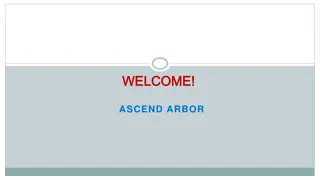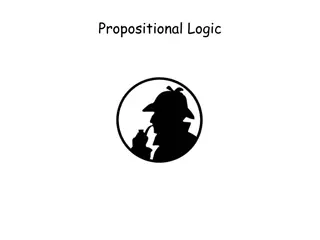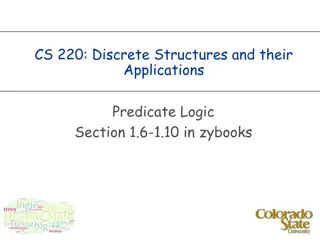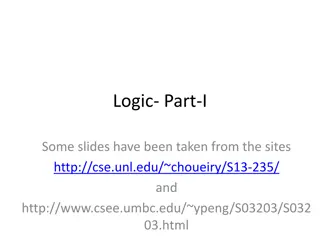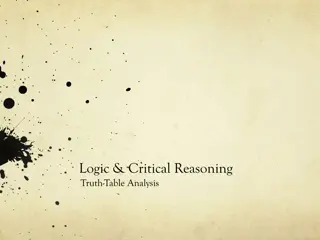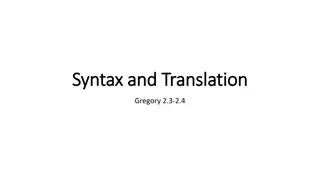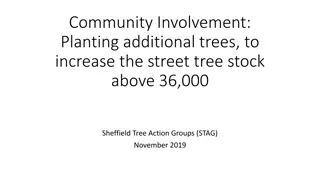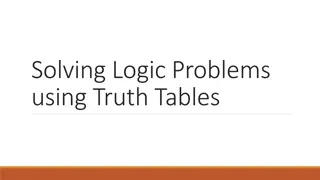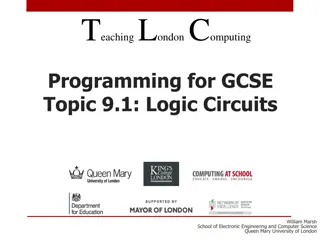Understanding Logic and Truth-Tree Analysis
Explore the concept of truth-tree analysis in logic, a method for testing the consistency of formulas and the validity of arguments. Learn about constructing truth trees, detecting consistency and inconsistency, evaluating validity, and determining tautologies and logical equivalence.
Download Presentation

Please find below an Image/Link to download the presentation.
The content on the website is provided AS IS for your information and personal use only. It may not be sold, licensed, or shared on other websites without obtaining consent from the author. Download presentation by click this link. If you encounter any issues during the download, it is possible that the publisher has removed the file from their server.
E N D
Presentation Transcript
Logic & Critical Reasoning Truth-Tree Analysis
Truth-Tree Analysis A tree-test is a consistency test for a given input of formulas. The stack is the input, and by applying the rules for tree construction one breaks down all complex formulas into either affirmations or negations of atomic statement letters. The main rule of the tree system is the closed path rule: Closed Path Rule: if a formula and its negation appear on the same path, then there is a contradiction on the path, and thus the path is closed. If there is no contradiction on a given path, the path remains open. The tree-test can be used to determine the answer to a number of questions that can also be determined via truth-table analysis
Consistency and Inconsistency The tree system is a method for testing whether a stack of formulas given as input is consistent or inconsistent. Consistent: A stack is consistent when there is at least one open path. Inconsistent: A stack is inconsistent when there are no open paths
Validity Validity: to test whether an argument is valid negate the conclusion of the argument, and check to see whether the stack containing the original premises and the negation of the conclusion is consistent. If the negation of the conclusion and the original set of premises leads to at least one open path, then the original argument is invalid. However, if the original premises, and the negation of the conclusion lead to all closed paths, then the original argument is valid. The key idea is that an argument is valid on a tree-test when the premises and the negation of the conclusion are inconsistent.
Tautology & Logical Equivalence Tautology: to test whether a formula is a tautology, negate the formula and check to see if the negation is a contradiction. If the negation of the formula is a contradiction, then the original formula is a tautology. However, if there is at least one path that is open, then the negation of the formula is consistent, and so the original formula is not a tautology. Logical Equivalence: to test whether two formulas are logically equivalent create a biconditional between the two formulas and test to see whether the biconditional is a tautology. In particular, negate the biconditional, check to see whether every path closes. If every path closes, then the original biconditional formula is a tautology, and the two formulas in particular are logically equivalent.
Rules for Tree Construction 1. Any time a formula occurs in a tree and the negation (if it is a negation, its affirmation) of the formula at some line below it on a connected branch one places an X underneath the formula, signifying that the branch is closed. X 2. A formula with two negations applying directly to it can be replaced on a line by the formula itself.
Rules for Tree Construction 3. A negated conditional is broken down into a single trunk with the affirmation of the antecedent followed by the negation of the consequent. ( ) 4. A conditional is broken down into two separate trunks, one trunk with the negation of the antecedent, and one with the affirmation of the consequent. ( )
Rules for Tree Construction 5. A conjunction is broken down into a single trunk with the affirmation of both conjuncts stacked. ( ) 6. A disjunction is broken down into two trunks, one trunk for each disjunct. ( )
Rules for Tree Construction 7. A biconditional is broken down into two trunks, one trunk has both the affirmation of the antecedent and the consequent, and the second trunk has the negation of both the antecedent and consequent. ( ) 8. A negated conjunction is broken down into two trunks; each trunk has a negation of one of the conjuncts. ( )
Rules for Tree Construction 9. A negated disjunction is broken down into a single trunk with each disjunct negated. ( ) 10. A negated biconditional is broken down into two trunks, one trunk contains the negation of the antecedent, and the affirmation of the consequent, the other trunk contains the affirmation of the antecedent, and the negation of the consequent. ( )
General Procedure for Constructing a Tree Step 1: Determine what question is being asked. For example, are you trying to determine whether a formula is a tautology, an argument is valid, or a set of formulas is consistent. Step 2: Given the question being asked alter the stack appropriately prior to building the tree. For example, if the question is whether the stack is consistent do not change any of the formulas since a tree-test is a consistency test. However, if the question is whether the argument is valid, then negate the conclusion prior to building the tree. Step 3: Follow the rules for tree construction, until every compound formula has been broken down. Check to see whether all paths close, or if at least one path is open.
Tips for Tree Construction Always trunk before you branch. If you have the option of breaking down two or more formulas you should always choose to break down a formula that has a trunk rule over breaking down any formulas with a branch rule. Trunk rules go straight down, branch rules split. To close a path all that matters is that there is some formula and it s opposite on the path. When looking to see if you can close a path all you need is some formula and it s opposite. It does not have to be in any order, nor does it have to be the opposite of the formula at the top of the path, the path just needs some formula and it s opposite. When breaking down formulas look for contradictions along the way. There are two ways to build a tree. One way is to break down all formulas and then look for contradictions. The other way is to look for contradictions as you build. The second way is superior because you trim your tree as you search for the answer.
Cases (P Q) R) Apply rule for (P Q) R Apply rule for P Q R No rule required
Cases (P Q) R) Apply rule for Apply rule for , followed by (P Q) R P Q R No rules required
Cases ( P Q) R) Apply rule for ( P Q) R Apply rule for P Q R No rules required






